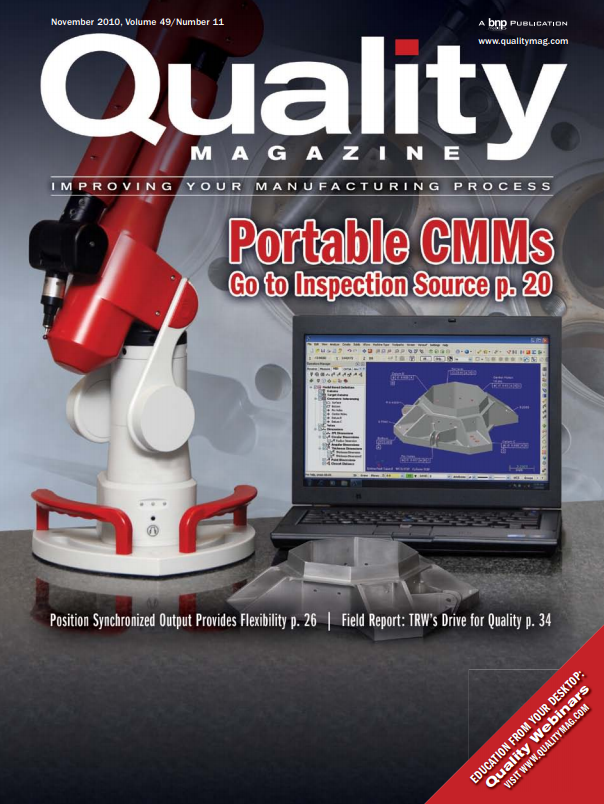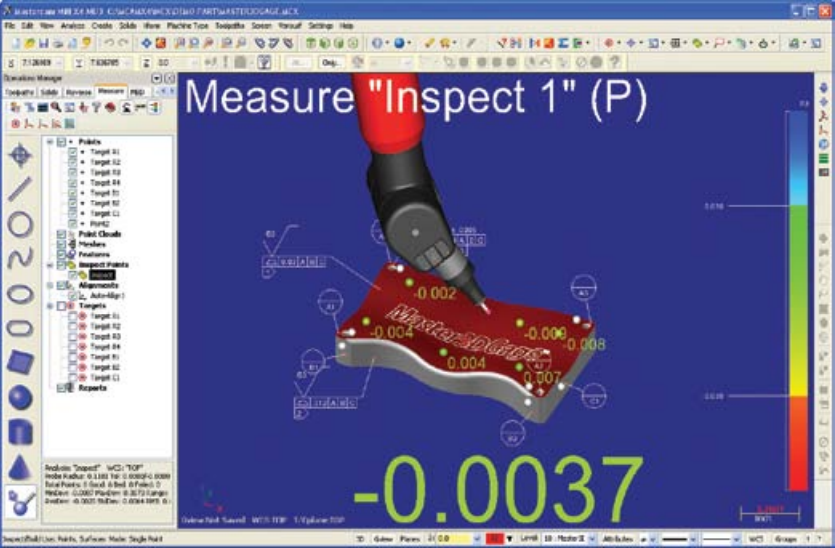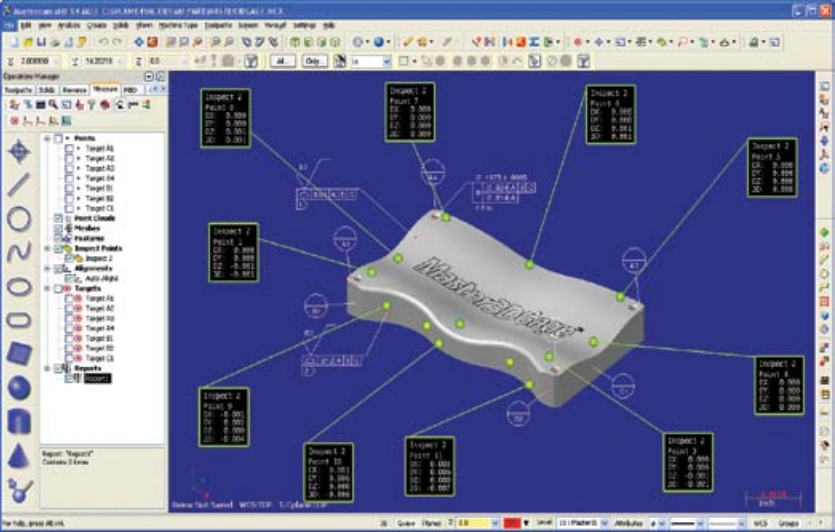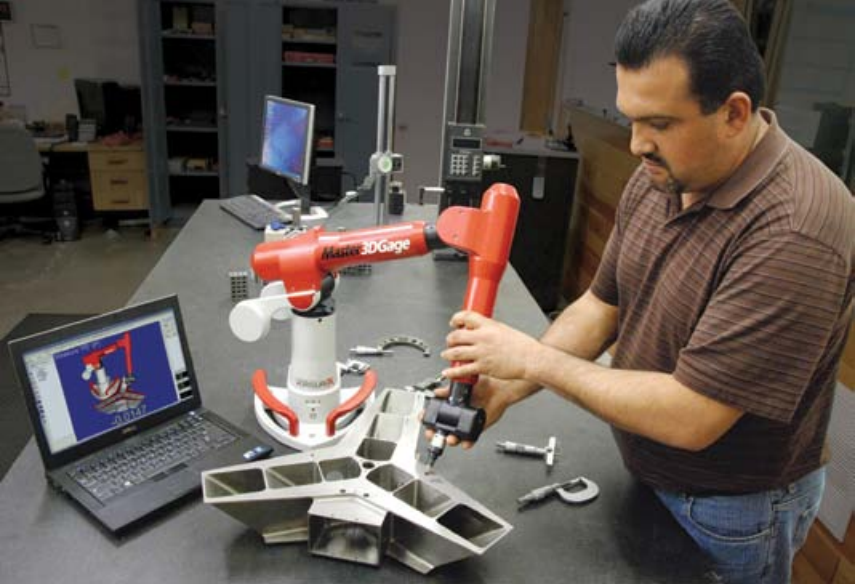Portable CMMs
Go to Source of Inspection
Read this story in Quality Magazine HERE
Get the PDF version of this story HERE
Quality Magazine cover story, November 2010, Discover how rapid shop floor inspection makes quick work of Quality, by Ron Branch
Discover how rapid shop floor inspection makes quick work of quality.
3-D measurements are taken on the floor at the source for immediate feedback and reporting against the engineering quality specifications. Source: Verisurf
The software will create prompted inspection plans as datums and features are selected while in teach mode. It also will provide real-time inspection data with visual, on-screen references. Source: Verisurf
When problems occur, turn the arm into an investigation tool. Rather than inspecting parts or processes to a predefined plan, use it to query the part to determine where the problem lies and what its root cause is. The arm offers the flexibility to conduct “what-if” diagnosis to understand the cause and effect. Source: Verisurf
For the machine shop that supplies the aerospace industry, portable coordinate measuring machine (PCMM) and model-based definition (MBD) are everyday terms that are integral parts of its daily inspection routines.
In the effort to drive quality and control processes, aerospace OEMs have altered the inspection methodology and the tools of their entire supply chain. Many of these suppliers are small- or mid-sized machine shops that have invested in inspection hardware, software, and processes to satisfy strict quality standards. With the success of these supply chain efforts, portable CMMs and the model based definition inspection technology are expected to spread to all industrial segments.
Now, it would appear that these new inspection tools and processes would place a big burden on the machine shop while benefitting only the aerospace manufacturer. It is true that this approach to quality control and inspection does demand more than what the usual assortment of hand tools and gages can deliver. It places much more emphasis on CMM-based inspections, which could mean a big investment in quality control. However, the new quality practices actually benefit the machine shop, fabricator or tool maker and it costs a lot less then they might expect.
By deploying PCMMs to the shop floor, these small businesses are realizing gains without staffing up in the quality control department. These companies are performing thorough and accurate measurements quicker than previously possible. They have adopted a convenient and efficient measurement process that covers everything from incoming inspection through final part inspection. And they have gained greater control over their processes.
So, how do these small shops respond to the demands of aerospace manufacturers and realize all of these advantages? They have adopted a rapid shop floor inspection approach: taking 3-D measurements on the floor at the source for immediate feedback and reporting against the engineering quality specifications.
The Tools
There are three items needed to implement rapid shop floor inspection: hardware, software, and engineering data.
To conduct inspections on the shop floor, a PCMM is needed. Although there are several options, the common PCMM choice for the small machine shop is typically an articulated arm with a positive contact probe.
Temporarily mounted on any rigid surface, these lightweight devices are easily transported anywhere in the shop. Arms have joints that let the machinist extend and rotate the measurement probe into every channel, bore or pocket. With a reach of 2 to 12 feet, the arms do not have physical size limits common with stationary CMMs. These features make them versatile inspection tools.
The second component of a rapid shop floor inspection system is the software that receives all of the information from the arm. In the most basic mode, the software will log and report measurements taken with the arm. However, the big gains in time and efficiency happen when the software’s full functionality is leveraged.
For example, the software will create prompted inspection plans as datums and features are selected while in Teach mode. It also will provide real-time inspection data with visual, on-screen references. To expedite the inspection process, it can import a computer-aided design (CAD) reference model for direct comparison of the manufactured part to its design intent.
Since the arm will be used in a variety of applications, the software will allow the operator several modes of operation:
- Direct measurements for on-the-fly spot checking as an alternative to a hand tool.
- Measurement to drawings in accordance with datums, dimensions, and geometric dimension and tolerance callouts.
- Direct comparison to a CAD model that contains the dimensional requirements.
The final piece of the rapid shop floor inspection solution is the quality specification and inspection plan. As just stated, the inspection work can be performed by referencing a part’s engineering drawings. This approach works fine, but the inspection process becomes much quicker when that data is assigned to a digital reference within the PCMM’s software.
Start by importing the 3-D CAD model and then assign the quality specifications from the drawings to the digital model. This allows the software to prompt where measurements are to be taken and immediately report a pass/fail condition.
For the fortunate shops whose clients have adopted MBD, the process becomes even faster. Since the model contains all the quality specifications, it is simply imported, and a few moments later inspections can be performed. This eliminates all the manual effort to interpret drawings, document measurements and report against the prints.
With these three components— PCMM, software, and quality specifications—machine shops have a portable inspection tool that is the equivalent of a cart full of hand tools and gages and a roll of engineering drawings. Everything that is needed to determine go/no go is bundled in a rapid shop floor inspection tool that travels to the workpiece.
The Process
The PCMM goes to the source of the inspection, which can be on the loading dock, manufacturing floor, machine shop or tool room. All that is needed is a little space and a stable work surface to mount the arm and place the part.
With battery operations and optional wireless communications, the truly portable systems do not even require a wall outlet or a cabled connection. After a quick calibration routine, the system is ready for operation.
The inspection process is simpler than that for a conventional CMM. In three simple steps—align, inspect and report—the process is complete. Start by placing the part within range of the arm. No fixturing is needed as long as the part does not move while measurements are taken. Next, probe the reference surfaces (for example, datums) that align the physical part to the digital CAD model. Now, the part is ready for inspection.
Take the desired measurements by touching the probe to the part and click the record button. Just touch and go on to the next measurement. Alternatively, drag the probe along a surface to pick up a continuous stream of measurements. With each measurement that is made, the system gives immediate, on-screen feedback. The dimensions and deviations are annotated in green when within the specified tolerance band and in red when the dimension fails.
When the inspection is complete, output the results in an inspection report that presents the information in the traditional tabular format augmented with any desired reference images.
The Advantages
As can be seen through the description of rapid shop floor inspection, it provides all of the capabilities of a stationary, programmable CMM while offering the convenience and flexibility of hand tools and hard gages. It is a multifunctional, go-anywhere, use-anytime inspection tool that does not have the overhead of time-consuming programming and does not need the skills of a highly trained metrology professional.
Measurement results are produced quickly with little effort, which is what the small to mid-sized shop needs. But how quick is it?
One aerospace supplier states that when inspecting with a measurement arm against a CAD reference model, the process took just 10 minutes. Without a PCMM and the CAD reference model, the same part took 6 hours to inspect. That company also offered an example comparing an arm to a CMM. Inspecting to prints, the arm was 75% faster than a manually operated CMM.
When asked how it chooses its inspection tools, another operator states, “We always look to do things the quickest way possible with the least amount of effort.” This is in line with what quality professionals have long realized: difficult and tedious processes can lead to short cuts that can result in quality problems.
This lessens the likelihood of running “at-risk,” minimizes scrap and production delays, and maximizes product quality. Rapid shop floor inspection is a versatile process that is used throughout manufacturing operations. Although sophisticated enough to satisfy the demands of the aerospace industry, it is perfect for the small or medium machine shop. While aerospace suppliers had little choice concerning the adoption of model-based definitions and PCMMs, these companies have become advocates of the tools. They see how efficiently they can gather data that confirms the quality of their parts, tools, and processes or identifies the source of process variance. And from their experience, they predict that this aerospace-promoted inspection process will rapidly extend into all commercial industries.
##
Ron Branch is an Applications Engineer for Verisurf Software Inc. (Anaheim, CA). For more information, call (714) 970-1683, email info@verisurf.com, or visit https://verisurf.com.
Verisurf Software, Inc.
Verisurf Software, Inc. is an advanced three-dimensional measurement solutions company committed to delivering advanced computer-aided inspection and reverse engineering solutions. Verisurf software helps manufacturers of all sizes and industries produce higher quality products in less time and at a lower cost with automated, Model-Based Inspection processes. For more information, visit the Verisurf website at https://verisurf.com.








